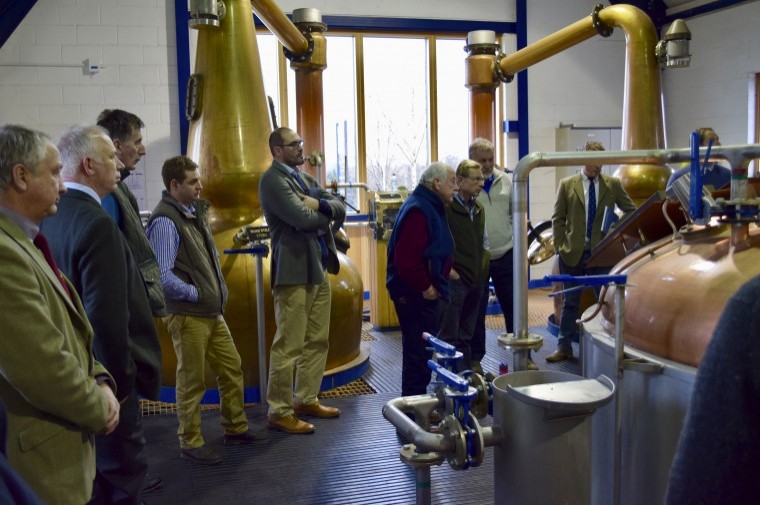Sowing “realistic” seed rates for individual field conditions and building nutrition early to support strong plant development were fundamental building blocks for a successful barley crop, Farmacy’s Bob Bulmer told growers at a recent Farmacy Norfolk event at St George’s Distillery near Thetford.
Without regular measurements, it was sometimes easy to overestimate establishment percentage in spring crops, which typically varied from 60-90% on many farms. This had big implications for the plant population, ear number and final grain yield, he warned.
“Yield is driven by grain number, which in turn is determined by ear number and tiller density. Barley, particularly two-row varieties, has less capacity to produce grains per ear compared to wheat, so getting the right number of plants established is a critical step in achieving high yields. You must be realistic about field losses when planning seed rates.”
A crop with 600 ears/m2 for example, would typically yield 6t/ha (assuming 21 grains/ear), whereas 800 ears/m2 would yield nearer 8t/ha, he noted.
Variable seed rates were a useful way of producing more uniform plant stands where soil type and seedbed conditions varied within fields and systems such as Omnia provided an ideal opportunity to do that, he said.
Support early growth
Dr Bulmer went on to explain that agronomy should be “front-loaded” to ensure plants established quickly, and nothing limited crop development.
“The main challenge with spring barley is to create sufficient biomass quickly enough so that crops can maximise light interception within the relatively short period between sowing and harvest.”
Early nutrition was key, and he suggested there were benefits from applying nitrogen, phosphate and potash to the seedbed to ensure these vital nutrients were readily accessible to young developing plants.
Phosphate in particular was needed for strong root development, something that was essential if higher-yielding crops were to access sufficient nutrients and water throughout the season.
In-season tissue analysis provided a useful indicator of potential nutrient deficiencies and was relatively quick and inexpensive, he said.
“Samples can be taken as soon as there’s enough leaf mass to do so, and you should get results back within seven to 10 days. It’s pretty indicative for most nutrients, although perhaps less useful for potash.”
Dr Bulmer’s agronomy tips:
- Sow into good seedbeds as spring barley is very sensitive to poor soil conditions
- Consolidate well to improve seed/root-to-soil contact
- Build fertility early – apply nitrogen, phosphate and potash to seedbed or soon after drilling
- Use early tissue analysis to identify nutrient deficiencies (e.g. manganese)
- Growth regulators can benefit rooting and tillering
- Consider foliar magnesium GS31 to flowering
- If irrigating in dry years, best time is shortly after ear emergence to support grain fill and late biomass production
- Grain analysis provides a useful retrospective measure of deficiencies to correct next season.
Growing market
Growers also heard how rising demand for malting barley products and new plant breeding techniques would reinforce spring barley’s place in many rotations over coming years.
“Spring barley faced major challenges last season and has been regarded as a Cinderella crop in the past, but grown correctly with the right contracts in place, it has a really good place on farm,” Farmacy agronomist Peter Riley said.
“East Anglian malting barley is already a big success story, the market is expanding and there is great technology coming from breeders.”
Mark Ineson from leading global malt supplier Muntons, said the firm had just announced £73m of investment over the next decade as it sought to meet rising demand for malt products produced at its sites in Stowmarket and Bridlington.
He acknowledged there was uncertainty about 2019 trade given Brexit, but the underlying market remained strong, especially in East Anglia where demand exceeded supply.
End user variety and quality requirements varied though, so he encouraged growers to tailor variety choice and agronomy to buyer specifications. Equally, if spring barley was grown for black-grass control, that should remain the focus, with agronomy tailored accordingly, he said.
Growers on lighter land were typically best placed to achieve the low grain nitrogen (<1.6%) required for distilling or brewing, while those on heavier land close to south coast ports could be better targeting higher nitrogen (<1.85%) favoured by exporters, he noted.
Technological improvements in plant breeding were helping bring new varieties to market more quickly, offering improved agronomics and end-user compatibility, added RAGT’s Cathy Hooper.
Double-haploid breeding, for example, was used to produce leading spring barley variety RGT Planet, and took about two years off conventional breeding techniques, she said.
Using genetic markers to identify desirable traits, such as disease resistance or yield, was another way technology was helping.
Work was also ongoing to develop low-GN (glycosidic nitrile) varieties for distilling, with a low-GN version of RGT Planet (currently approved for brewing) about to enter its second year of official trials and could be commercially available in 2022, she said.




